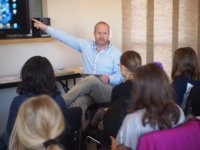Blended Learning: We Are All New Teachers
Your content has been saved!
Go to My Saved Content.The challenges facing a new teacher are clear: how to write a strong lesson plan, how to master the fine art of lesson delivery and how to keep kids engaged in a positive classroom environment are all high on the list. Add to that list the addition of mastering the use of technology tools to support instruction with students, and many a new teacher might go running for the hills!
In all seriousness, though, the need for a new teacher to be able to learn the fine art of incorporating Web 2.0 tools to support instruction with students is critical if we are to stay the course of 21st Century instructional reforms. Not only that, the research is clear that strategies that combine the use of traditional face-to-face classroom methods with computer-mediated activities are here to stay. Enter the blended learning model.
Defining Blended Learning
In researching for this post, I found a significant amount of information across the Internet regarding the definition of blended learning. What it is, what it's not, and the fact that some say that it's not a new concept at all, but rather the re-birth of something that's been around for awhile -- just now with a new name.
There are many definitions of blended learning to be sure, but for our purposes let's take the definition of blended learning from Innosight Institute which defines blended learning as: a formal education program in which a student learns at least in part through online delivery of content and instruction with some element of student control over time, place, path, and/or pace and at least in part at a supervised brick-and-mortar location away from home. The institute even goes on to say: there are four models of blended learning that categorize the majority of blended-learning programs emerging across the K-12 sector today. These four models are: Rotation, Flex, Self-Blend, and Enriched Virtual. (Not a perfect definition by any means, but one that gives us food for thought.)
Quite a hefty piece of information for any teacher, let alone a new teacher, to digest!
Which leads me to my next point. There are tremendous resources available to us from books to blog posts, videos to white papers that will support an educator to learn about, identify different models of, and seek to begin to utilize blended learning in their practice. The problem that I found is that none seem to address how a very "new teacher" might get started working in this model.
Getting Started
A talented California educator Catlin Tucker defines blended learning as "a formal education program in which a student is engaged in active learning at least in part online where they have some control over the time, place, and/or pace and in part at a brick and mortar location away from home." She's an expert in the work on blended learning and has written a book on the topic. Not only that, her blog shares in great detail ways that a teacher might work to begin to utilize the concept of blended learning in the classroom.
From her blog, here's what Tucker says about getting started:
I agree with Catlin and love her enthusiasm for the model! My take away from her quote, as it pertains to a new teacher, is that like any teaching strategy, the desire to use a blended learning model can be accomplished given the time to plan, the right resources and technology tools and most importantly (in my humble opinion) the use of collaboration with other colleagues who are invested in this concept.
Resources
Teachers no longer have to begin from scratch if they have a desire to teach using a blended learning model. With the recent explosion of digital educational resources, there are a number of great ones, which can help a teacher dive right into blending learning. However, as a new teacher, it can be quite overwhelming to make sense of it all. If you are interested in considering how you might begin to use a blended learning model in your classroom, here are a few suggestions:
- Read Catlin Tuckers post: Top 10 Reasons that Blended Learning is Worth the Hype! Read everything you can on Catlin's site about the ins and outs of blended learning.
- Examine free resources such as those available at Khan Academy and at Education Elements.
- Research the use of a Learning Management System, LMS. This "virtual classroom space" would support you to share lessons, provide discussions, use Web 2.0 tools to demonstrate learning, and communicate with your students and parents in a blended learning model. One that many educators are using successfully is Collaborize Classroom.
- Set aside time to plan (with colleagues and/or a mentor) how you might begin to use current student data and curriculum content to individualize teaching for students in a blended learning model.
- When you're ready...Get support to launch your blended learning model in your classroom community.
- Be prepared for potential setbacks or bumps in the road on the blended learning path. Don't be discouraged. Keep working on refining your process and get feedback from an experienced teacher using the model.
Blended learning fosters creation in our students and lends itself to differentiated instruction. Check out this recent video created to support teachers who are interested in learning how to begin to use blended learning with their students.
The field of blended learning is moving full steam ahead with many eager teachers taking charge of crafting the future of this model to bolster the learning of their students. Will you be ready to take up the challenge?
